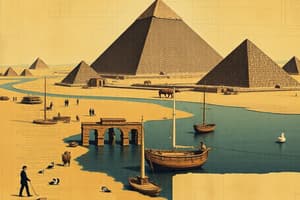Podcast
Questions and Answers
The ancient Egyptian civilization flourished along the ______ River for over 3,000 years.
The ancient Egyptian civilization flourished along the ______ River for over 3,000 years.
Nile
The ______ was considered a divine ruler in ancient Egyptian society.
The ______ was considered a divine ruler in ancient Egyptian society.
pharaoh
The ______ Kingdom is known for the age of pyramids and a strong centralized government.
The ______ Kingdom is known for the age of pyramids and a strong centralized government.
Old
Ancient Egyptians believed in a ______ religion with multiple gods, including Ra and Osiris.
Ancient Egyptians believed in a ______ religion with multiple gods, including Ra and Osiris.
Hieroglyphics is a writing system that combines logographic and ______ elements.
Hieroglyphics is a writing system that combines logographic and ______ elements.
The ______ Kingdom marked the height of ancient Egyptian power with extensive building projects.
The ______ Kingdom marked the height of ancient Egyptian power with extensive building projects.
Ancient Egyptians developed a calendar based on lunar and ______ cycles.
Ancient Egyptians developed a calendar based on lunar and ______ cycles.
Factors leading to the decline of ancient Egypt included invasions and internal ______.
Factors leading to the decline of ancient Egypt included invasions and internal ______.
Flashcards are hidden until you start studying
Study Notes
Overview
- Ancient Egyptian civilization flourished along the Nile River for over 3,000 years.
- Known for its contributions to art, architecture, writing, and governance.
Geography
- Centered around the Nile River, providing fertile land and irrigation.
- Major regions: Upper Egypt (southern) and Lower Egypt (northern).
Timeline
- Pre-Dynastic Period (c. 6000–3150 BCE): Formation of early communities.
- Early Dynastic Period (c. 3150–2686 BCE): Establishment of the first pharaohs.
- Old Kingdom (c. 2686–2181 BCE): Age of pyramids; strong centralized government.
- Middle Kingdom (c. 2055–1650 BCE): Expansion of trade and arts; literature flourished.
- New Kingdom (c. 1550–1070 BCE): Height of power; extensive building projects, including temples.
Society and Culture
-
Social Structure:
- Pharaohs: Considered divine rulers.
- Nobles and priests: Held power and wealth.
- Scribes: Educated class managing records and administration.
- Farmers and laborers: Majority of the population, engaged in agriculture.
-
Religion:
- Polytheistic, with gods like Ra (sun god), Osiris (afterlife), and Isis (motherhood).
- Belief in the afterlife; importance of mummification to preserve bodies for the next world.
-
Art and Architecture:
- Monumental structures: Pyramids, temples, and monuments (e.g., Great Pyramid of Giza).
- Hieroglyphics: Writing system combining logographic and alphabetic elements.
- Art was highly symbolic and often religious.
Achievements
- Mathematics and Astronomy: Developed a calendar based on lunar and solar cycles; contributed to geometry.
- Medicine: Advanced medical practices, including surgery and herbal remedies.
- Trade: Engaged in extensive trade networks with neighboring regions.
Decline
- Factors leading to decline include invasions (e.g., Sea Peoples), internal strife, economic challenges, and shifts in trade routes.
- Conquered by various empires including the Assyrians, Persians, and eventually the Greeks under Alexander the Great.
Legacy
- Influenced later civilizations in governance, architecture, and culture.
- Continued interest in Egyptian history and artifacts, contributing to modern archaeology and Egyptology.
Overview
- Ancient Egyptian civilization lasted over 3,000 years, thriving mainly along the Nile River.
- Renowned for significant advancements in art, architecture, writing, and governance.
Geography
- The Nile River was central to civilization, providing fertile land and irrigation essential for agriculture.
- Divided into Upper Egypt (southern region) and Lower Egypt (northern region).
Timeline
- Pre-Dynastic Period (c. 6000–3150 BCE): Early communities began to form.
- Early Dynastic Period (c. 3150–2686 BCE): First pharaohs were established, marking the start of dynastic rule.
- Old Kingdom (c. 2686–2181 BCE): Known as the Age of Pyramids; characterized by a strong centralized government.
- Middle Kingdom (c. 2055–1650 BCE): Expansion in trade, arts, and notable literature emerged.
- New Kingdom (c. 1550–1070 BCE): Peak of power with extensive construction projects, notably temples and monuments.
Society and Culture
- Social Structure:
- Pharaohs held the divine right to rule, seen as gods on earth.
- Nobles and priests wielded considerable power and wealth.
- Scribes were the educated elite responsible for administration and record-keeping.
- The majority of the population comprised farmers and laborers involved in agriculture.
- Religion:
- Polytheistic beliefs included gods like Ra (sun), Osiris (afterlife), and Isis (motherhood).
- The afterlife was significant; mummification practices were vital for preserving bodies for the next life.
- Art and Architecture:
- Renowned for monumental constructions such as pyramids and temples, including the Great Pyramid of Giza.
- Developed hieroglyphics, a writing system featuring logographic and alphabetic elements.
- Art was deeply symbolic and primarily religious in nature.
Achievements
- Mathematics and Astronomy: Created a calendar based on solar and lunar cycles; made significant contributions to geometry.
- Medicine: Advanced practices included surgical techniques and the use of herbal remedies.
- Trade: Established extensive trade networks with neighboring regions, facilitating cultural and economic exchange.
Decline
- Declining factors included invasions, such as those by the Sea Peoples, internal conflicts, economic troubles, and changes in trade routes.
- Experienced conquest by various empires, including the Assyrians, Persians, and ultimately the Greeks led by Alexander the Great.
Legacy
- Left a lasting impact on future civilizations, influencing governance, architecture, and cultural practices.
- Ongoing interest in Egyptian history and artifacts has enriched modern archaeology and the field of Egyptology.
Studying That Suits You
Use AI to generate personalized quizzes and flashcards to suit your learning preferences.




